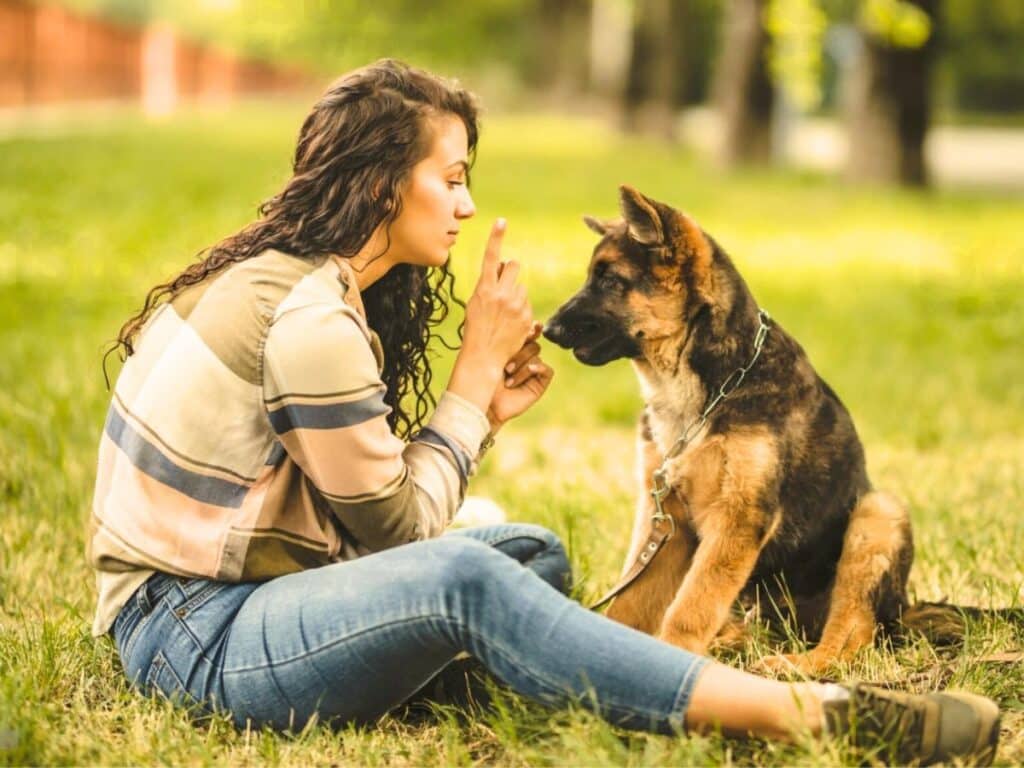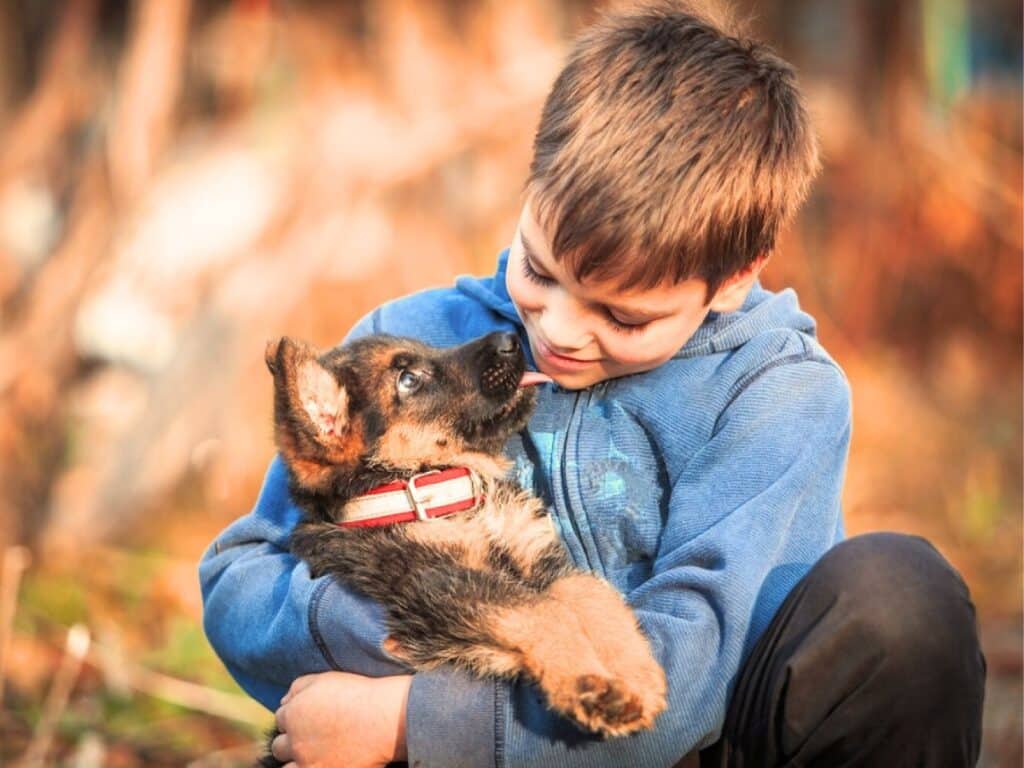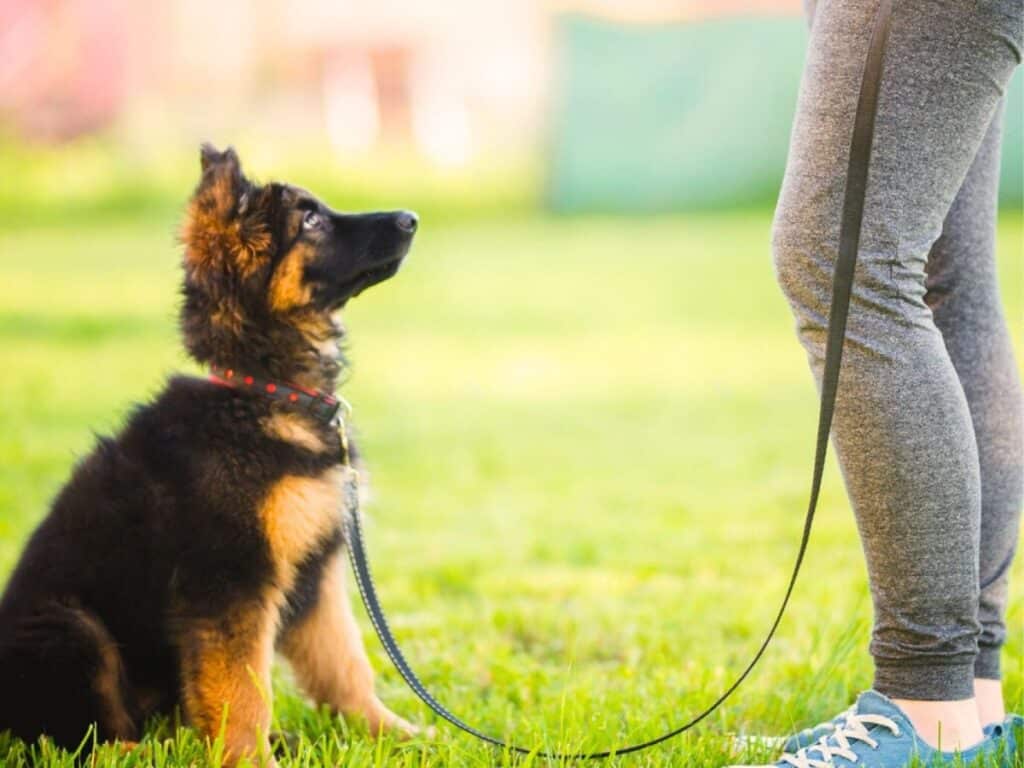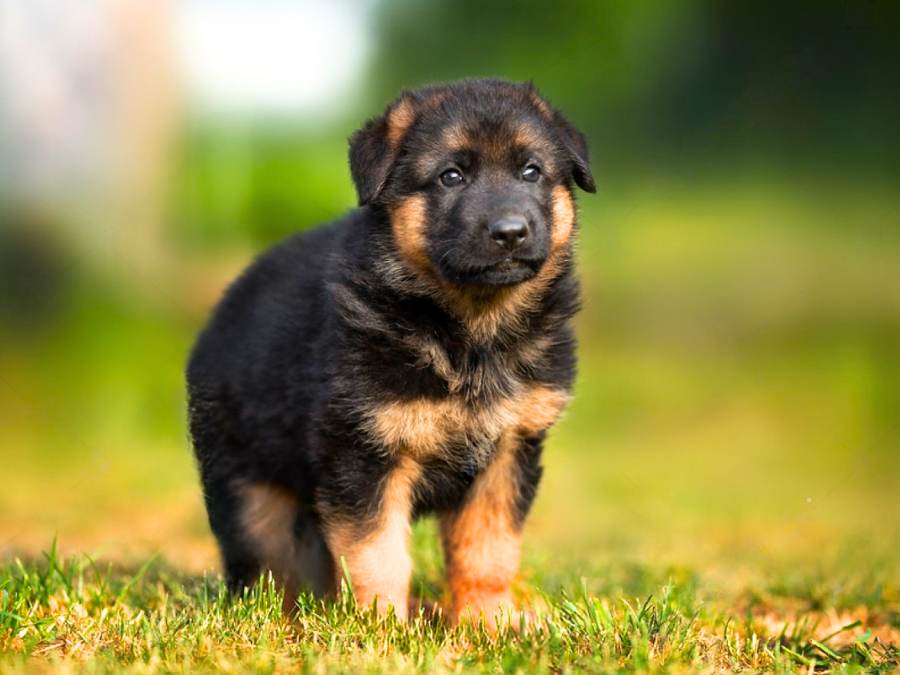Welcome to this beginner’s guide to German Shepherd training commands, where you’ll unlock the secrets to communicating with your furry, four-legged friend like never before.
Whether you’re a seasoned dog owner or a wide-eyed beginner, this article is your ticket to unleashing your pup’s maximum brain power.
And the best part? I’ve got a printable GSD training guide with all the 30 commands that you can download to help you along the way.
From “Sit” to “Stay” to “Dance with me” I’ve got you covered with easy-to-follow tips and tricks.
Trust me, your pooch will thank you for reading this. So let’s get started!
German Shepherd Training Commands
The following chart presents a compilation of 30 German Shepherd training commands that we will discuss in this guide.
In the following sections, I will provide step-by-step instructions on how to effectively train your puppy on each of these 30 commands.
Essential German Shepherd Puppy Training Commands
| COMMAND | WHAT IT TEACHES |
| 1. Name Recognition | Responding to their name |
| 2. Sit | Sitting on command |
| 3. Down | Lying down on command |
| 4. Stay | Remaining in place until released |
| 5 Come | Coming to you when called |
| 6. Speak | Barking on command |
| 7. Quiet | Ceasing barking or being quiet on command |
| 8. Wait | Pausing or staying in place |
| 9. Watch me | Making eye contact with you |
| 10. Leave it | Ignoring or avoiding a specific item or command |
| 11. Drop it | Releasing an object from their mouth |
| 12. Stand | Standing on command |
| 13. Heel | Walking politely by your side |
| 14. Dance with me | Standing on their hind legs and “dancing” with their front paws |
| 15. Let’s go | Moving or following you |
| 16. Up | Jumping onto a surface or object |
| 17. Off | Getting off furniture or discontinuing an action |
| 18. Shake | Offering their paw for a handshake |
| 19. Roll over | Rolling onto their back and side |
| 20. Fetch | Retrieving an object and bringing it back |
| 21. Take it | Taking an object in their mouth |
| 22. Go Potty | Eliminating in a designated spot |
| 23. Go to your bed | Going to a designated spot or bed |
| 24. Jump | Jumping over an obstacle or onto a raised surface |
| 25. Spin | Turning around in a circle |
| 26. Back up | Moving backward |
| 27. Crawl | Crawling forward on their belly |
| 28. Close the door | Nudging a door closed with their nose |
| 29. Get in the car | Entering a car on command |
| 30. Go eat | Starting to eat when given the command |
Training your pup is crucial for obedience and safety. These cues can be taught through verbal commands or hand signals and must be reinforced regularly to ensure the dog remembers them in any situation.
New commands can be added with patience and repetition, and using treats and toys as rewards can make training fun for both the dog and the trainer.
Remember that safety is paramount, and training should be tailored to suit the dog’s individual needs and personality.
With this essential guide, you can master German Shepherd Training Commands and enjoy a happy, well-behaved dog for life.
Basic and Advanced Commands
German Shepherd Training Commands are a crucial element of training dogs. They can be divided into two categories – Basic and Advanced Commands.
- Basic commands include “Sit,” “Stay,” and “Come.” These commands are essential for daily routine activities and ensure that the dog remains in control under all circumstances.
- Advanced commands such as “Fetch,” “Off” and “Heel” require more time, patience, and understanding between the trainer and the dog. Mastery of these commands can take anywhere from several weeks to months based on the experience level of the trainers involved.
- The use of hands-free techniques such as collars is also essential when introducing some of these advanced concepts.
RELATED: Are German Shepherds Easy To Train?
Basic Commands for German Shepherds
German Shepherds are intelligent and responsive dogs that can be trained to perform several commands.
Here are some essential commands that every German Shepherd owner should train their dog to follow:
Make sure that you use a Positive Marker
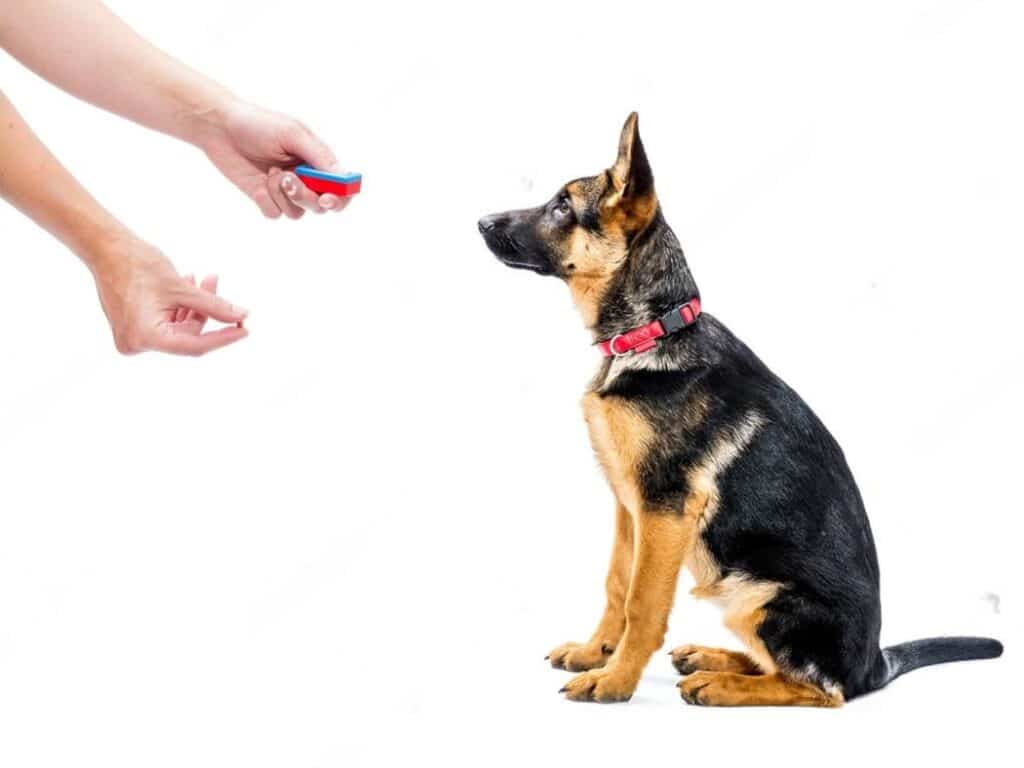
Using a Cue to Reinforce Positive Behavior
Utilizing a positive marker can be instrumental in training your German Shepherd.
A positive marker is essentially a sound or signal that reinforces desired behavior.
This can be achieved by making a distinctive sound, such as “good boy” or “yes,” and then providing the dog with a reward.
The key is to consistently use the same sound each time your German Shepherd performs the correct action.
You can begin implementing this technique during basic commands such as sit or stay and progressively incorporate it into more complex exercises like heel or come.
Implementing positive markers will help your German Shepherd understand what actions merit rewards, which motivates them to continue performing those behaviors.
This method of training reinforces good behaviors in a way that keeps your dog engaged and creates mutual trust.
1. Name Recognition
Recalling a dog’s name is vital for effective communication during training sessions.
Training your pup for Name Recognition involves teaching your pet to recognize and respond correctly when their name is called out.
It’s essential to start with short, straightforward names that are easy to pronounce.
During their meal times or leisure time, get their attention by calling their name in an affectionate tone.
Praise them every time they look up at you. Gradually, increase the distance between you and your pet while still calling out their name.
It’s crucial not to rush through this phase of training as it serves as the foundation for future commands.
2. Sit
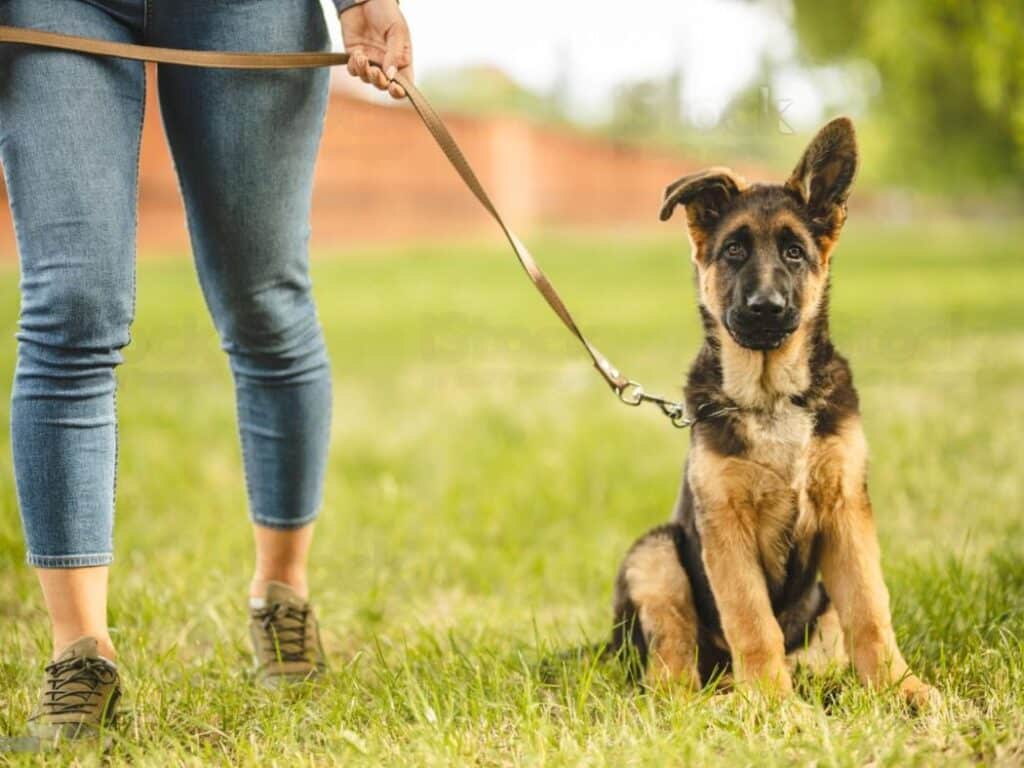
Teaching the “Sit” command establishes essential discipline and reinforces calm behavior.
Begin by commanding your dog to sit, and then use the “quiet” command as necessary to prevent barking or whining.
Pat their head once they have settled down.
To further reinforce good behavior, use a leash and collar in combination with verbal commands to teach your dog not to pull while on walks.
German Shepherds are intelligent dogs and can perform more intricate commands than sit or stay.
For example, they will learn how to hold items in their mouth or drop them on your command if you teach them well enough.
For instance, I taught my German Shepherd how to fetch my slippers. It took me a few days of practice but eventually, he was able to sniff out and grab my slippers from anywhere in the house and deliver them right to me.
It’s an excellent example of the capabilities this breed has when trained properly with even the basic commands provided in this blog post.
RELATED: German Shepherd Price: Total Cost of Buying & Maintaining a GSD
3. Down
Teaching your German Shepherd the command to lie down is an essential aspect of dog training.
This command is typically the last step in a series of dog commands, and it entails the dog lying flat on the ground with its belly facing down.
The “lay down” command will help you manage your pet’s behavior effectively when placed in stressful situations.
When teaching your German Shepherd the “down” command, make sure you are consistent and use positive reinforcement.
Squeeze the treat or toy under his nostrils to lure him into a lying position until you can say “down”.
You must be patient as it takes time for some dogs to figure out how to lower their bodies.
While teaching your dog how to lay down, choose an appropriate location with minimal distractions like noises or smells.
After perfecting its form, introduce distractions as well as different areas where you can practice the exercise—such as outdoor spots.
4. Stay
Remain in Place
Training your German Shepherd to stay in place is a vital component of their obedience.
It can prevent them from running into dangerous situations or following you when they shouldn’t.
Begin by issuing the “Sit” command and then use the “Stay” command while making eye contact with your dog.
Once they are still, gradually increase the duration of time before rewarding them with a treat.
To maintain your dog’s focus and attention, try mixing up when you reward them.
It could be after five seconds or even five minutes of maintaining their position.
Moreover, introduce distractions like food or toys to test their discipline level further.
If your dog fails to comply with this command, avoid punishment but instead redirect and correct them gently.
Always end the training session on a positive note, rewarding their progress and hard work.
5. Come
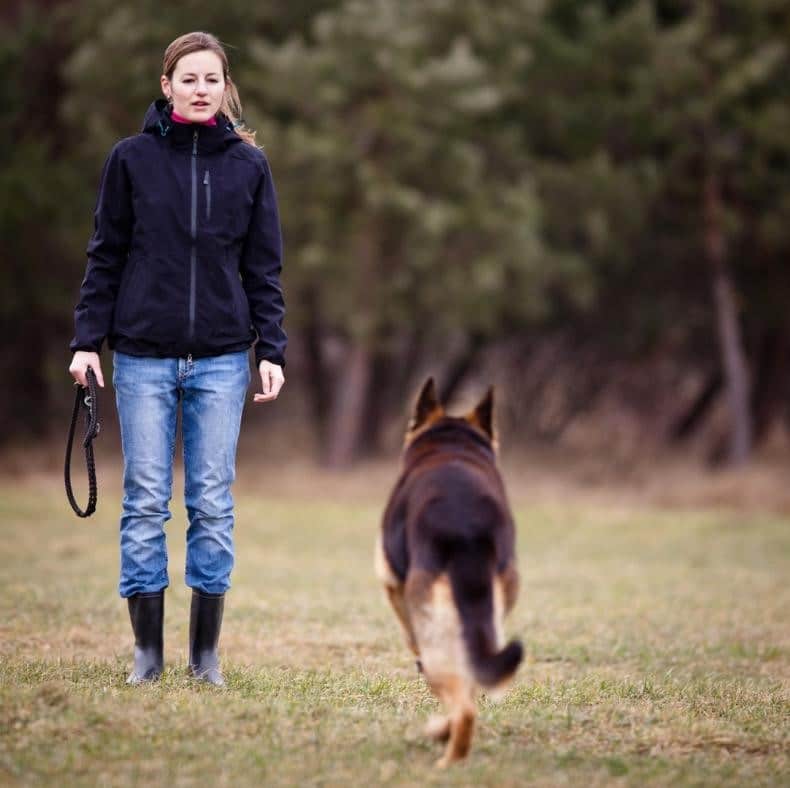
Responding to your call is an important part of German Shepherd training.
The command ‘Come‘ plays a vital role in ensuring that your furry friend follows your instructions.
To teach the ‘Come‘ command, use a leash and let your dog loose in a safe environment.
Call their name, followed by the word ‘Here‘ or another keyword of your choice.
When they come, reward them with treats, and pet them affectionately.
It is necessary to train your German Shepherd to follow the “come” command promptly and consistently for their safety and well-being.
6. Speak
Encourages Vocalization
Encouraging vocalization is crucial while training a German Shepherd to speak.
Start by holding your dog’s toy and commanding “speak” while fixing eye contact with it.
Once your dog starts barking or whining, encourage the behavior by giving its toy as a reward.
Repeat the command several times until the dog gets accustomed to the signal and associates it with the action.
To specifically reinforce barking behavior, teach another command like “watch me.”
Once your dog is focused on you after hearing this cue, command “speak.”
Keep giving rewards every time it barks until the desired result is achieved.
Religiously practicing these techniques would let you effectively encourage give-and-take interactions with your German Shepherd through vocalizations.
A study revealed that dogs can actually understand human language – showing similar brain activity patterns when spoken to in their right temporal cortex as humans!
7. Quiet
It is imperative for your German Shepherd to learn to be still and calm, so teaching your pet the ‘Quiet’‘ command is essential because it helps them focus, watch their environment more attentively and remain relaxed throughout the day.
To create foundational knowledge regarding ‘Quiet‘, you will have to start by communicating with your pet in a clear, firm tone.
Upon saying the command, ensure that you wait patiently for behavioral manifestation so that they know what you want from them.
This way, when another situation calls for them to stay still or quiet, they can easily recall the command.
One crucial unique detail to note is that training your German Shepherd thoroughly on commands such as Quiet gives you better control over social activities with other people and animals.
If visitors come over, or while out in public places with your dog, using this command ensures that they do not whine or bark excessively or distract others around you.
RELATED: How To Stop German Shepherd Puppy From Biting
8. Wait
To train your German Shepherd, utilize “Wait” to teach them to stay in place until released. Start with a sit command and then use the hand signal for stop.
Repeat the signal and slowly back away. Say the release word before giving a treat only after a few seconds of successful “Pausing”.
With “Wait” mastered, it is easier to discourage bad behavior or keep your pup from dashing through open doors or crossing streets.
This command aids in teaching patience to impulsive German Shepherds, which can improve their overall behavior.
To reinforce this skill in different scenarios and environments, introduce distractions, but be patient and consistent.
Utilize physical signals, including backing away with a hand outstretched or keeping eye contact while delivering the release word.
9. Watch Me

To capture the attention of your German Shepherd, establish eye contact and use an imperative tone with a phrase that demands their attention, such as “Focus” or “Watch me”
It is important to hold their gaze until they make compliant eye contact.
This command aids in establishing basic communication and also assists in creating a deeper bond between you and your German Shepherd.
With “Watch Me”, you can teach your German Shepherd to focus on you immediately, particularly during distractions or chaos.
In challenging situations such as road crossings or crowded areas, this command helps prevent accidents by holding your dog’s attention.
Please be aware that if you have trained your German Shepherd to maintain eye contact as part of a command or cue, they may develop a habit of staring at you even when there is no specific prompt to do so.
10. Leave It
Dogs are naturally curious and may encounter harmful substances or objects. “Leave it” helps prevent them from gobbling up something dangerous or potentially toxic, keeping them out of harm’s way.
Your GSD’s impulse control gets a boost with “Leave it.” It teaches them self-restraint and helps them understand boundaries, making them a well-behaved and respectful companion.
To teach the “Leave it” command to your dog, hold a treat in your closed hand and let your GSD sniff it. Say “Leave it” in a firm but friendly tone.
Your pooch will likely paw or nudge your hand. Stay patient and keep repeating “Leave it” until they stop trying to get the treat.
Once they back off, immediately praise and reward them with a different treat or verbal praise.
11. Drop It
When it comes to preventing your German Shepherd from taking something it shouldn’t, the command “Drop It” can be very helpful.
This command instructs your dog to let go of an item on command and puts you in control of what they are allowed to have.
To begin training your dog with this command, start by offering them a toy or object that they frequently like to hold onto.
Once they have it in their mouth, offer them a treat and say the command “Drop It.”
When they release the toy or object to receive the treat, reinforce the behavior positively with praise.
Consistently using this training technique will condition your dog to drop whatever is in its mouth upon receiving the “Drop It” command.
As you begin practicing this command with different objects and toys, try combining it with other commands such as “Come” so that you can address multiple behaviors at once.
12. Stand
Encourage your German Shepherd to ‘Stand,’ by giving a clear command while standing in front of them.
This command is useful for grooming, and vet check-ups and often precedes other commands such as ‘Stay‘ or ‘Heel‘.
To train your German Shepherd to stand, place them in a sitting position, gently place one hand on their chest and another behind their hindquarters.
Then issue a clear verbal command ‘Stand‘ and gently encourage them to rise up into a standing position. Repeat this exercise until they understand the command.
13. Heel

By teaching your dog to “heel”, you maintain control and keep them close to you, especially in potentially dangerous situations like busy streets or crowded areas. It reduces the risk of accidents or them running off.
To achieve this level of obedience, start with short sessions where you encourage your dog to walk alongside you without pulling on the leash.
Use a clicker or verbal cue like “heel” each time your dog stays on track.
Alongside these cues, make sure you consistently reward your dog with treats or praise every few seconds they remain beside you without pulling the leash while walking.
It is important to note that when teaching the ‘heel’ command, avoid pulling or harshly tugging your furry friend’s leash as it can incite fear in them – an emotion that stifles obedience rather than encourages it.
14. Dance with me
The “Dance with Me” command may seem like a fun and silly trick, but dancing together strengthens the bond between you and your furry friend.
It builds trust and enhances your communication, as you both learn to move in sync and enjoy each other’s company.
To teach “dance with me” command to your pup, choose a catchy tune that makes you want to move. Start by capturing your dog’s attention with a treat or a favorite toy.
While holding the treat or toy above your dog’s head, gently sway side to side or take a small step back and forth.
Encourage your dog to stand on its hind legs or paw in the air as if they’re dancing.
As you’re dancing, say “Dance with Me” in an enthusiastic tone. Repeat the command each time you engage in the dancing motion.
Whenever your dog shows any movement or mimics your dance steps, shower them with verbal praise, treats, or playtime. Positive reinforcement will reinforce the desired behavior.
15. Let’s Go
This training command is used to signal your German Shepherd to start moving forward with you. A suitable variant of this command could be ‘Let’s Go‘.
Once your dog has understood the command and starts moving with you, keep them motivated by using positive reinforcement such as treats or praise.
This command is useful during daily walks or when maneuvering in crowded areas.
16. Up
To teach your German Shepherd the command ‘Up’, first, lure them with a treat or toy to jump up onto an object.
Once on the object, say ‘Up’ and offer praise along with another treat. This command can be useful for getting your dog onto furniture or into cars.
Another way to train this command is by using a stool or low step.
Start by having your dog stand beside the stool, then encourage them to jump up onto it by saying ‘Up’.
Be patient and repeat until they successfully complete the action.
17. Off
The “Off” command is a handy tool to teach your dog to remove itself or its paws from a person, object, or location.
“Off” establishes boundaries and teaches your dog to respect personal space.
It’s particularly useful when they’re jumping on people, furniture, or countertops.
By teaching your dog to respond to “Off,” you can prevent them from jumping on guests or strangers, ensuring polite and controlled interactions.
To teach “off” command to your dog, create a situation where your dog is likely to jump up, such as when they greet you or encounter a tempting surface.
As soon as your dog starts to jump up, calmly and firmly say “Off” and immediately redirect their attention to the ground.
The moment all paws are on the ground, praise your dog and offer a treat.
18. Shake
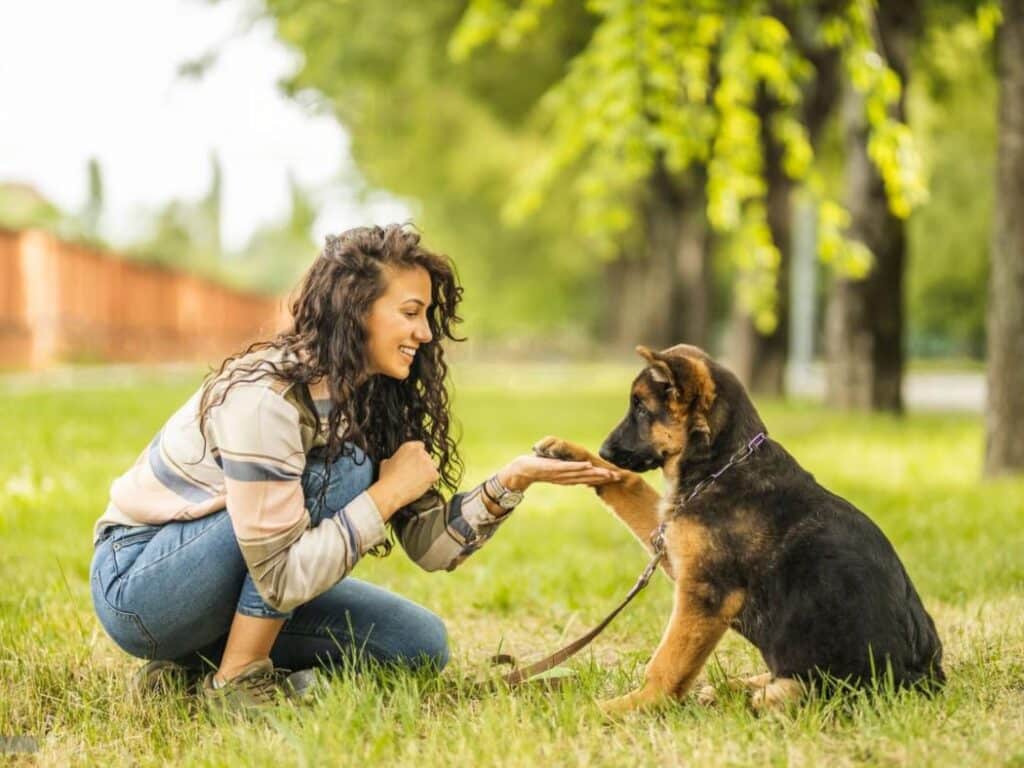
“Shake” involves the pup offering you its paw as if to shake hands.
To teach this trick, start with your dog sitting in front of you.
Hold a treat in your fist and raise it up slightly. Your dog will likely try to reach for it with their paw- at this point, say ‘Shake!’ and reward them when they touch your hand with theirs. Repeat until they understand the command.
Another variation to teach is called ‘High Five’. Once your pup has mastered ‘Shake’, hold out your palm instead of a closed fist when asking for their paw. Immediately upon contact, say “High Five!” and give them a treat.
19. Rollover
One of the most interesting commands is when your dog rolls over on command.
Training your German Shepherd to roll over requires patience and consistency.
Start with your dog in a “Down” position. Hold a treat close to their nose and slowly move it towards their shoulder, encouraging them to follow it with their head.
As your dog follows the treat, continue moving it in a circular motion, guiding them to roll onto their side.
Use a verbal cue like “Roll over” to associate the command with the action.
Once your dog completes the roll, reward them with a treat and shower them with verbal praise.
Keep practicing until they can do it without needing a treat or physical lure.
Pro Tip: Dogs can find rolling over uncomfortable if their training surface is hard, so provide a comfortable mat or carpet for their safety and comfort during training sessions.
20. Fetch
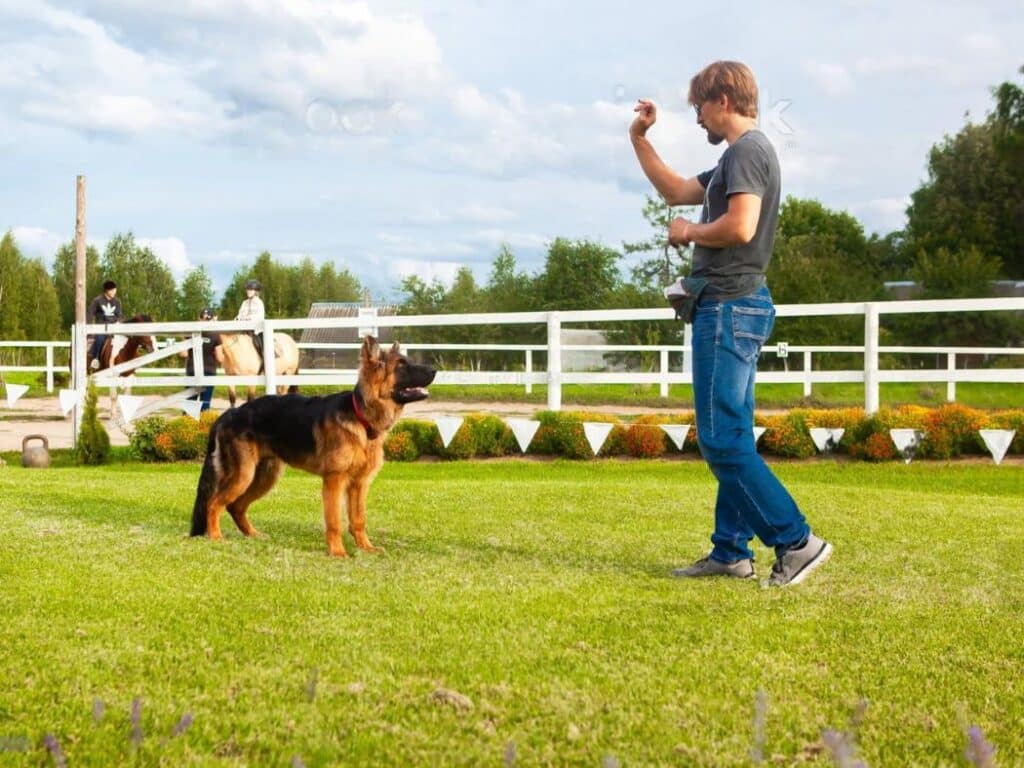
One of the most popular German Shepherd training commands is to ‘Fetch’. Retrieving objects helps in strengthening your dog’s memory and focus.
This command also strengthens communication between you and your furry friend.
When implementing this command, start by teaching your German Shepherd to fetch a toy or an object that interests them.
Use positive reinforcement techniques like treats and praise to encourage this positive behavior.
As soon as your German Shepherd has learned how to retrieve basic objects, advance to more challenging commands such as retrieving specific items like keys, remote controls, or even slippers.
A fun twist on this command is hide-and-seek fetch, where you hide the object for your dog to find before returning it.
Keep this activity both mentally stimulating and physically active for a healthy exercise routine.
21. Take It
The “Take it” command is indeed used to teach your dog when it’s appropriate to take something.
Teaching your dog when it’s acceptable to take something helps establish boundaries and self-control.
They learn to wait for your cue before engaging with an item, preventing impulsive grabbing or snatching.
To teach this command to your dog, Start with a specific item that your dog finds interesting, such as a toy or treat.
Show the item to your dog and hold it out in your open hand, allowing them to sniff and investigate.
As your dog shows interest, say “Take it” in an enthusiastic tone. Be consistent with your verbal cue.
If your dog makes any attempt to grab the item, even if it’s just a slight touch or lick, praise them and allow them to take it from your hand.
22. Go Potty
Dogs require proper potty training, which is vital for a German Shepherd’s overall behavior and hygiene maintenance.
One of the essential commands to teach a GSD is ‘Go Potty,’ which can be used to train them to do their business on command.
To teach this command to your pup, select an area outside where you want your dog to go potty consistently.
It could be a specific patch of grass or a designated gravel area.
Decide on a clear and consistent verbal cue like “Go potty” or “Get busy.” Stick with this phrase throughout the training process.
Take your dog to the designated spot at regular intervals, especially after meals, naps, and playtime. Consistency is crucial to establish the routine.
Put your dog on a leash and lead them to the designated spot. Use the verbal cue “Go potty” as you enter the area.
Give your dog time to sniff and explore the area. Use encouraging words and praise while they are in the process of eliminating.
Immediately after your dog finishes, offer verbal praise and a treat.
23. Go to your bed
The command “Go to your bed” helps provide your dog with a designated space where they can relax and feel safe.
It also helps in situations where you want your dog to stay in a specific area, such as when guests come over or during mealtime.
To teach this command to your doggy, choose a specific bed or mat that will serve as your dog’s designated spot.
Make sure it’s comfortable and appealing to them.
Encourage your dog to approach the bed by using treats or a favorite toy. You can toss treats near the bed to create a positive association.
When your dog steps onto or near the bed, use a verbal cue like “Go to your bed” in a clear and firm tone.
Reward your dog with treats, praise, and petting when they follow the command and settle on the bed.
24. Jump
The command “Jump” can be useful in various situations, such as during agility training or when you want your dog to safely and willingly jump over obstacles.
However, it’s important to note that jumping can put strain on your dog’s joints, so it should be taught and practiced carefully to avoid any potential injuries.
Here’s how you can teach your dog the “Jump” command:
Start with a low obstacle, such as a small hurdle or a raised object like a low box.
Show your dog a treat or a toy on the other side of the obstacle to grab their attention and motivate them.
Stand on one side of the obstacle and encourage your dog to follow you towards it. You can use a verbal cue like “Jump” or “Over.”
As your dog approaches the obstacle, guide them over it using a hand gesture or by holding the treat/toy on the other side.
Reward your dog with treats, praise, and play when they successfully jump over the obstacle.
25. Spin
The command “Spin” is a fun and engaging trick that can provide mental stimulation for your dog.
It helps improve their coordination, focus, and body awareness.
Here’s how you can teach your dog the “Spin” command:
Start with your dog standing in front of you. Have some small, soft treats ready as rewards.
Hold a treat in front of your dog’s nose, and slowly move it in a circular motion towards their shoulder.
This will encourage them to follow the treat with their nose and initiate a spin.
As your dog begins to turn around, use a verbal cue like “Spin” or “Turn” to associate the command with the action.
Once your dog completes the spin, reward them with the treat and give plenty of verbal praise and petting.
26. Back up
The command “Back up” helps in situations where you want your dog to move away from something or create space between them and a particular object or person.
Here’s how you can teach your dog the “Back up” command:
Start in a quiet area with your dog facing you. Have some small, soft treats ready as rewards.
Hold a treat in front of your dog’s nose, and take a step towards them. This should prompt them to take a step back.
As your dog starts to move backward, use a verbal cue like “Back up” in a clear and firm tone to associate the command with the action.
Reward your dog with a treat and praise as soon as they take a step back.
27. Crawl

Teaching your dog to crawl helps improve their body awareness, coordination, and concentration.
More importantly, its a lot of fun seeing your dog crawl.
Here’s how you can teach your dog the “Crawl” command:
Start with your dog in a lying down position.
Hold a treat close to their nose, and slowly move it towards the ground, just a few inches away.
As your dog follows the treat and starts to crawl forward, use a verbal cue like “Crawl” in a clear and firm tone to associate the command with the action.
Reward your dog with the treat and plenty of praise when they make any forward movement with their body.
Gradually increase the distance between your dog and the treat, encouraging them to crawl farther to reach it.
28. Close the door
The command “Close the door” is a practical and useful command to teach your dog. It can help prevent drafts, keep unwanted pests out, and maintain privacy.
Additionally, teaching your dog to close the door can be a fun and impressive trick to show off to friends and family.
Here’s how you can teach your dog the “Close the door” command:
Start by selecting a door that your dog can easily reach and push closed. Make sure the door is not too heavy or difficult for them to handle.
With the door slightly ajar, entice your dog’s attention by holding a treat on the opposite side of the door.
As your dog moves towards the treat, gently encourage them to use their nose or paw to push the door closed.
As soon as the door starts to move in the desired direction, use a verbal cue like “Close the door” in a clear and consistent tone.
Once the door is fully closed, reward your dog with the treat and praise them enthusiastically.
29. Get in the car
The command “Get in the car” is important for several reasons.
It allows you to safely and easily transport your dog in a vehicle, whether it’s for a trip to the vet, a family outing, or any other travel need.
Teaching your dog to get in the car on command promotes safety, reduces stress, and makes traveling with your GSD more convenient for both you and your furry friend.
Here’s how you can teach your dog the “Get in the car” command:
Start by having your car parked in a safe and familiar location. Make sure the doors are open and the interior is accessible.
Use treats or a favorite toy to entice your dog to approach the car. Reward them for any positive interaction with the car, such as sniffing or touching it.
Stand near the car door and encourage your dog to come closer. Use a verbal cue like “Get in the car” in a clear and inviting tone.
If your dog hesitates or shows resistance, gently guide them towards the car by placing treats or toys near the entrance.
Once your dog steps inside the car or puts its paws on the car’s floor, reward them with treats, praise, and affection.
30. Go eat
The command “Go eat” is important as it helps establish a clear routine and boundaries around mealtimes for your dog.
By teaching your dog to associate this command with going to their designated eating area, you can prevent them from begging for food or trying to eat from inappropriate sources.
Here’s how you can teach your dog the “Go eat” command:
Choose a specific location where you want your dog to eat, such as a designated feeding area or their feeding station.
Place your dog’s food bowl in the designated area and use a consistent phrase like “Go eat” each time you are about to feed them.
Encourage your dog to approach the designated area by pointing towards it or leading them there with their food bowl.
Once your dog reaches the designated area, use the verbal cue “Go eat” and allow them to start eating.
Reinforce the behavior by giving verbal praise and allowing your dog uninterrupted access to their food.
Why training a German Shepherd is so important?
Training a German Shepherd is important for several reasons:
1. Safety: German Shepherds are large and powerful dogs. Training helps them understand and obey commands, which ensures their behavior is predictable and reduces the risk of accidents or aggression towards humans or other animals.
2. Bonding: Training sessions provide an opportunity for you and your German Shepherd to build a strong bond.
Dogs are social animals, and training promotes communication and understanding between you and your pet. It helps establish trust and enhances your relationship.
3. Behavioral Issues: Without proper training, German Shepherds can develop behavioral problems such as excessive barking, chewing, jumping, or digging.
Training teaches them appropriate behavior and helps address any existing issues, making them well-mannered companions. (Source)
4. Socialization: German Shepherds are known for their loyalty and protective nature. Training helps them interact positively with people, other animals, and different environments.
This socialization ensures they can adapt to various situations without becoming overly anxious or aggressive.
5. Mental Stimulation: German Shepherds are intelligent and active dogs that require mental stimulation to thrive.
Training provides mental exercise and challenges their problem-solving skills. It helps prevent boredom, which can lead to destructive behavior.
6. Obedience and Control: German Shepherds have a strong instinct to follow a leader. Training establishes you as the pack leader and teaches your dog to respond to commands consistently.
How long does it take to train a German Shepherd?
The time it takes to train a German Shepherd can vary depending on various factors, including the dog’s age, previous training, temperament, and the goals you have for your dog.
Training is an ongoing process that requires consistency, patience, and dedication.
Basic obedience training typically takes several months to establish a solid foundation of commands such as sit, stay, come, and heel.
This initial training can take anywhere from a few weeks to a few months, depending on the individual dog and the amount of time you dedicate to training each day.
More advanced training, such as specialized tasks or complex commands, may take additional time and ongoing reinforcement.
Specialized training, such as search and rescue or protection work, can take months or even years to fully develop the necessary skills.
How many commands can German Shepherd learn?
According to Stanley Coren, a Ph.D. researcher from the University of British Columbia, highly intelligent dogs such as German Shepherds have the ability to understand an average of about 150-200 words or commands.
This indicates their remarkable cognitive capabilities and their capacity for language comprehension.
To put this into perspective, the mental abilities of a German Shepherd can be likened to that of a 2-year-old human child.
This means that they possess similar cognitive potential and are capable of learning new commands relatively quickly compared to other dog breeds.
Beyond the basic commands like ‘sit’, ‘stay’ ‘stand’, German Shepherds can learn an extensive list of commands and tasks, including:
1. Advanced obedience commands: Once the basic commands are mastered, German Shepherds can learn more advanced obedience commands like “leave it,” “drop it,” “wait,” “stand,” and “watch me.”
2. Tricks: German Shepherds can also learn a variety of tricks such as shaking hands, rolling over, playing dead, crawling, jumping through hoops, and many more. These tricks provide mental stimulation and can be fun for both you and your dog.
3. Specialized tasks: German Shepherds are often trained for specialized tasks such as search and rescue, police or military work, therapy or service dog tasks, and competitive dog sports like agility or obedience trials. These tasks involve complex commands and require extensive training.
How to Teach Your German Shepherd Training Commands?
Here are some steps you can follow to effectively teach commands to your German Shepherd:
1. Start with basic commands: Begin with basic obedience commands such as sit, stay, come, and heel. These commands form the foundation for all other training and are essential for your dog’s safety.
2. Use positive reinforcement: Reward your German Shepherd with treats, praise, and affection when they successfully perform the command. Positive reinforcement helps to motivate and encourage your dog and strengthens the bond between you.
3. Keep training sessions short and frequent: German Shepherds have a high energy level and can become easily bored or distracted. Short, frequent training sessions of 10-15 minutes are more effective than longer sessions.
4. Use clear and consistent cues: Use a clear and consistent cue for each command, such as a hand signal or verbal command. Repeat the cue several times during each training session, and be patient as your dog learns.
5. Gradually increase the difficulty: Once your dog has mastered a command, gradually increase the difficulty by adding distractions or distance. This helps to reinforce the command in different contexts and situations.
6. Seek professional guidance: If you are having difficulty teaching your German Shepherd commands or need help with advanced training, seek professional guidance from a qualified dog trainer or behaviorist.
What Training Equipment Do I Need To Train My German Shepherd?
When training your German Shepherd, there are a few essential training equipment items that can help facilitate the process. Here are some commonly used training tools:
1. Collar and Leash
A sturdy collar and leash are basic necessities for controlling your German Shepherd during training sessions. Opt for a well-fitted collar made of durable materials, and choose a leash of appropriate length for different training exercises.
2. Training Treats
High-value treats are excellent motivators for your German Shepherd. Use small, easily consumable treats that your dog finds enticing. Treats should be soft, bite-sized, and preferably low in calories to avoid overfeeding.
3. Clicker
A clicker is a small handheld device that produces a distinct clicking sound when pressed. It helps to mark the exact moment your dog performs a desired behavior correctly. Clickers are often used in positive reinforcement training, allowing you to communicate precisely and reinforce good behavior.
4. Long Line
A long line is a training tool that allows your German Shepherd to have more freedom while still being under your control. It’s a long leash typically ranging from 15 to 30 feet (4.5 to 9 meters) in length. A long line is useful for practicing recall commands or training in open areas while maintaining control over your dog’s movements.
5. Interactive Toys
Interactive toys can be used during training sessions to keep your German Shepherd engaged and mentally stimulated. Toys such as puzzle toys or treat-dispensing toys can help reinforce positive behavior and provide an outlet for your dog’s energy.
Conclusion
In summary, mastering German Shepherd training commands is crucial for an obedient and well-behaved dog. By consistently using precise commands and positive reinforcement, you can effectively teach your dog to follow instructions and behave appropriately. Keep in mind that each dog is unique and may require individualized training approaches. By being patient, consistent and understanding, you can foster a strong bond with your German Shepherd while also establishing good behavior and manners.
Five Facts About German Shepherd Training Commands:
- ✅ German Shepherds are highly trainable and excel at obedience training. (Source: American Kennel Club)
- ✅ There are many different training commands that are important for German Shepherds to learn, including sit, stay, come, heel, and leave it. (Source: German Shepherd World)
- ✅ Training should begin early in a German Shepherd’s life to prevent bad habits from forming. (Source: Dogtime)
- ✅ Positive reinforcement training methods are the most effective for German Shepherds, using rewards like treats, praise, and playtime. (Source: The Spruce Pets)
- ✅ Consistency and patience are key to successful German Shepherd training, as these dogs thrive with routine and repetition. (Source: K9 of Mine)
Frequently Asked Questions (FAQs)
What are some essential German Shepherd training commands?
Some of the essential German Shepherd training commands include sit, stay, come, heel, down, and fetch. These commands help establish discipline, obedience, and good behavior in your dog.
How often should I repeat these German Shepherd training commands?
It is important to repeat these commands at least once a day until your dog responds to them consistently. Once your dog has mastered the commands, you can reduce the frequency of repetition.
What is the best way to train German Shepherd puppies with these commands?
Start training your German Shepherd puppy at an early age. Use positive reinforcement techniques such as giving treats and praise when your puppy follows the commands correctly. Keep training sessions short and fun to avoid overwhelming your puppy.
What should I do if my German Shepherd does not respond to these training commands?
If your German Shepherd is not responding to the training commands, try to identify the problem. It could be due to distractions in the environment, inconsistency in your training approach, or insufficient training time. Address the problem accordingly and consider seeking professional help.
Can I train my German Shepherd to perform advanced commands?
Yes, German Shepherds are intelligent and capable of learning advanced commands such as agility, search and rescue, and protection training. However, these require specialized training and should only be attempted with the help of a professional dog trainer.
What are some common mistakes to avoid when training German Shepherds?
Some common mistakes include using punishment instead of positive reinforcement, training your German Shepherd for too long, and failing to be consistent with your training approach. It is important to establish a clear communication channel with your dog and to be patient and consistent in your training sessions.

